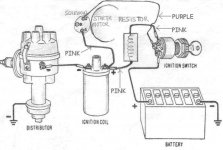- Moderator
- #21
- Joined
- Nov 9, 2000
- Messages
- 7,543
- Location
- Edgerton, Ohio, United States
- Corvette
- 1959 black 270hp (9/2/69) 1981 Beige L81(10/20/80)
Man I know how you feel. I still work on these things at 68 and I feel it for a week.
Since you are using a remote starter just take out the number one spark plug. Hold your thumb on the spark plug hole and turn over the engine with your remote switch. When number one is coming up on the compression stroke air will blow your thumb off (the hole, not your hand). Stop cranking when you feel the pressure building and gently bump the starter until the balancer timing mark lines up with the 0 on the pointer. You are now at top dead center on number one. Now you can check the rotor orientation to the cap posts for number one. No need to mess with valve covers.
Tom
Since you are using a remote starter just take out the number one spark plug. Hold your thumb on the spark plug hole and turn over the engine with your remote switch. When number one is coming up on the compression stroke air will blow your thumb off (the hole, not your hand). Stop cranking when you feel the pressure building and gently bump the starter until the balancer timing mark lines up with the 0 on the pointer. You are now at top dead center on number one. Now you can check the rotor orientation to the cap posts for number one. No need to mess with valve covers.
Tom





